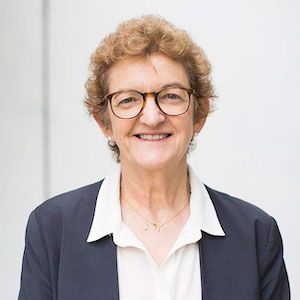Article
Clinical Diagnosis of Obstructive Sleep Apnea Not Associated with AMD Likelihood
Author(s):
Results from the analysis suggest participants treated for previously diagnosed obstructive sleep apnea experience a significantly higher risk of having RPD coexistent with AMD.
Professor Robyn H. Guymer
Credit: Center for Eye Research Australia

New research suggests a clinical diagnosis of obstructive sleep apnea (OSA) was not associated with a higher likelihood of age-related macular degeneration (AMD), nor with the presence of reticular pseudodrusen (RPD) with AMD.1
However, the analysis showed individuals undergoing treatment for previously diagnosed OSA experienced a significantly higher risk of having RPD coexistent with AMD, but not overall AMD, compared with those not receiving treatment.
“When considering individuals with a formal diagnosis of OSA, who were also receiving treatment using an assisted breathing device, while they were not more likely to have AMD, they were 3.7 times more likely to have RPD coexistent with AMD compared with those who were not receiving treatment for OSA,” wrote the investigative team, led by Professor Robyn H. Guymer, MBBS, PhD, from the Centre for Eye Research Australia at the Royal Victorian Eye and Ear Hospital.
Increasing evidence has suggested that hypoxia may play a critical role in the pathogenesis of AMD, with the retinal pigment epithelium (RPE) and photoreceptors being highly metabolically active. Oxygen tension in the outer retina is reduced in darkness, and any additional factor that alters oxygen delivery to the retina could increase hypoxia and predispose AMD progression. Common disorders that cause nocturnal hypoxia are known as sleep-disordered breathing, with the most common being OSA.2
Studies investigating SDB use questionnaires to assess the risk of SDB, including the Epworth Sleepiness Scale (ESS) and the STOP-Bang questionnaire (SBQ). The ESS includes 8 questions that allow participants to subjectively assess their sleepiness in 8 different situations, while the SBQ is a questionnaire with 8 questions assessing factors contributing to an increased risk of OSA.
Participants with AMD in the current analysis were recruited from existing natural history studies at the Centre for Eye Research Australia and ophthalmology practices, with control patients recruited from staff, friends, and unrelated family members of the AMD participants. Controls were required to have no evidence of drusen >63 µm on optical coherence tomography (OCT) imaging. Participants were excluded with a prior diagnosis of an ophthalmic condition associated with nocturnal hypoxia, as well as those with other retinal conditions or those requiring daytime oxygen therapy.
A binary risk scale based on the combined ESS and SBQ and an ordinal risk scale based on the SBQ determined a participant's risk of having moderate-to-severe OSA. During the questionnaires, participants were asked if they had a previous diagnosis of OSA and whether they were currently receiving treatment at night through an assisted breathing device. Retinal imaging was obtained within 6 months of conducting the sleep questionnaires and allowed for the determination of AMD and RPD status.
The study included a total of 351 participants, where 211 (60.1%) had AMD and 140 (39.9%) were control participants. The mean age of participants with AMD (75.6 years) was significantly older than the control group (71.3 years), and the AMD group had a higher proportion of female patients (69.7% vs. 54.3%; P = .003).
The analysis showed a formal diagnosis of OSA was not associated with a significantly higher likelihood of having AMD present (odds ratio [OR], 1.63; P = .319), not a higher likelihood of having RPD coexistent with AMD (OR, 1.97; P = .187), compared with those without a formal OSA diagnosis. For individuals who had a formal diagnosis of OSA and underwent treatment with an assisted breathing device, there was no association with AMD (OR, 2.70; P = .149). However, a formal OSA diagnosis and assisted breathing device treatment were significantly associated with an increased likelihood of having AMD with RPD (OR, 3.70; P = .042).
Moreover, logistic regression analysis for the assessment of OSA risk using the binary scale showed no association of high-risk of moderate-to-severe OSA with AMD presence (OR, 1.13; P = .698) or with RPD coexistent with AMD (OR, 1.05; P = .885). The assessment using the ordinal scale revealed having an intermediate or high risk of having moderate-to-severe OSA was additionally not associated with the presence of AMD (P = .519), nor AMD with RPD (P ≥.551). A per point increase in ESS or SBQ questionnaire score was not associated with presence or AMD (OR, 1.09; P = .441), not RPD with AMD (OR, 1.16; P = .252).
Guymer and colleagues noted a potential mismatch between patients identified as being at high risk of AMD and those who experience hypoxia at night may have played a role in the lack of association observed in their findings.
“The lack of association could be due to the fact that the sleep questionnaires are only screening tools for the diagnosis of OSA, since being at high risk of OSA does not necessarily mean that one has OSA or experiences hypoxic episodes at night and similarly not showing increased risk on the sleep questionnaire does not mean that they do not have OSA,” investigators wrote.
References
- Fang WY, Rama Raj P, Wu Z, et alRole of sleep-disordered breathing in age-related macular degenerationBMJ Open Ophthalmology 2023;8:e001203. doi: 10.1136/bmjophth-2022-001203
- Foldvary-Schaefer NR, Waters TE. Sleep-disordered breathing. 15 Continuum (Minneap Minn) 2017;23:1093–116.





